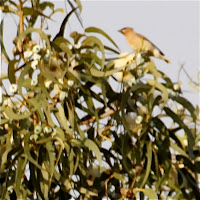Hang on though, is that one on the left a bit smaller with pale undertail coverts?...
Well, not quite, but it was missing almost all of its tail and undertail coverts which gave it quite an odd look. In the shot below it is on the far right - its single tail feather trailing behind it. Waxwing flocks appear to be regular targets of Sparrowhawk attacks - maybe this bird narrowly missed capture?
Looking at the other birds in the photo below gives an indication of the difference in width of the yellow terminal band on the tail. A clear broad band indicates a male, a narrow band is more likely to belong to a female.

 The same bird is now perched behind another with a full tail complete with chestnut undertail coverts. The lowest bird appears to have reduced yellow in its tail, though that is exaggerated by shadow here I think.
The same bird is now perched behind another with a full tail complete with chestnut undertail coverts. The lowest bird appears to have reduced yellow in its tail, though that is exaggerated by shadow here I think.
So the above birds are clearly Bohemian Waxwings with or without damaged tails. Cedar Waxwing is, of course, the species that I was looking for when checking the undertail coverts of birds in this flock. An extreme rarity this side of the Atlantic, I caught up with Cedar Waxwing for the first time only this year in while birding in Big Morongo Canyon, California. The shot here on the right, though very poor, shows just how visible the white undertail coverts are on this species.
For those who don't know, the Big Morongo Canyon contains an oasis at the transition between the Mojave and Sonoran desert areas. The oasis area is reputed to have one of the highest densities of breeding birds in North America. After just one brief mid-day visit, it is well and truly on my list as a place to return to for some leisurely birding.
The Big Morongo oasis, along with the nearby Covington Park, is also a reliable site for the stunning Vermillion Flycatcher. The whole family certainly appreciated this bird - especially given the proximity of the play park!



1 comment:
Nice pics, Sprawk seems likely for one missing tail. Interesting details on tailband variations in BWP, in addition to sexual difference first adult marginally narrower too, though so much overlap that no use on its own. Also reference there to the straight tailband of male and shallow V of female, though again seems marginal. Plus depth of yellow, i.e. colour, deeper yellow in males and also age related. I do not recall seeing red in tail tips (but stated in Hungary as 45% in ad m, 12% ad f, 12% 1st-win m, 0.6% 1st-win f). Lots of fun for a form of mystery photo competition if you had a known age bird!
Post a Comment